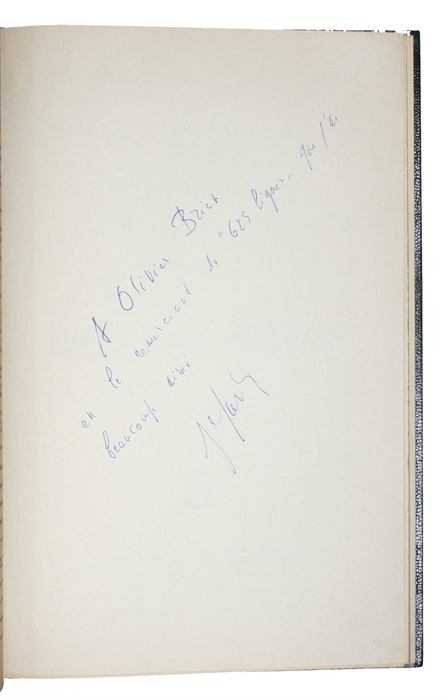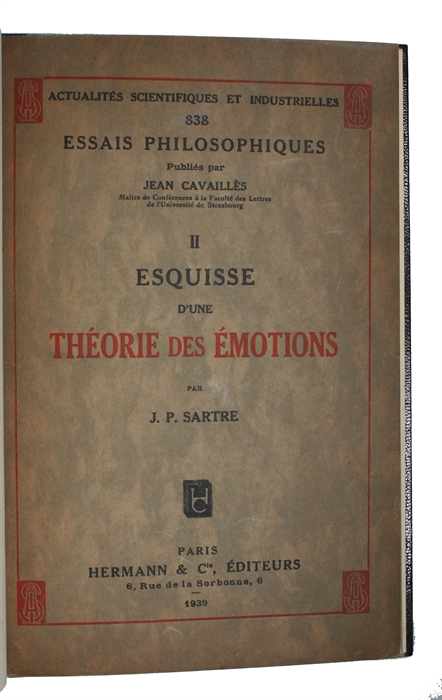PRESENTATION-COPY
SARTRE, J.P.
Esquisse d'une Théorie des Émotions.
Hermann & Cie, 1939. Royal 8vo. Bound uncut with the original printed wrappers ("Actualités scientifiques et industrielles", no. 838. Essais philosophiques II, Publiés par Cavaillès), also the backstrip (mounted with a little loss). in an exquisite, beautiful black morocco binding with gilt horizontal and vertical lettering to spine. Beautiful silvered paper over boards. Housed in an exquisite silvered marbled paper slip-case with black morocco edges. Binding signed to bottom of inside of front board: "C. et J-P. Miguet". Near mint copy. 52 pp.
First printing, presentation-copy, of Sartre's highly important early philosophical work, which is recognized as the best introduction to his "L'Étre et le Néant" (1943). The work was only printed as it is here, as no. 838 of Cavaillè's "Actualités scientifiques et industrielles", and only appeared in a new (not revised) edition in 1960.
The large presentation-inscription reads as thus : " A Olivier Briot/ en la remerciant de " Les lignes " qui j'ai/ beaucoup aimé/ JP Sartre ".
"L'Esquisse d'une théorie des émotions " (" Sketch for a Theory of the Emotions"), although now considered one of Sartre's most important works, was originally written as the first part and introduction to a greater work on psychological phenomenology that was supposed to be entitled "La Psyché". The great psychological project was abandoned due to Sartre's eagerness to finish "Le Mur". "L'Esquisse" thus remains the only part of the work ever published, and perhaps exactly because of its introductory character, it has come to have the effect on modern philosophical thought that it has. Due to being at the same time accessible and rigourous, the work is considered the best introduction to Sartre's fundamental philosophical ideas, an almost indispensible presentation of and introduction to "L'Étre et le Néant", which appeared four years later.
"L'Esquisse d'une théorie des émotions " is a phenomenological essay on emotion, in which Sartre ettempts to present a phenomenological psychology, treating emotion as a " phenomenon " and placing it within the realm of signification. The primary presentation of his own phenomenological analysis is essantial to all his later philosophy.
"Although written fairly early in his career, in 1939, Sketch for a Theory of the Emotions is considered to be one of Jean-Paul Sartre's most important pieces of writing. It not only anticipates but argues many of the ideas to be found in his famous Being and Nothingness. By subjecting the emotion theories of his day to critical analysis, Sartre opened up the world of psychology to new and creative ways of interpreting feelings. Emotions are intentional and strategic ways of coping with difficult situations. We choose to utilize them, we control them, and not the other way around, as has been posited elsewhere. Emotions are not fixed; they have no essence and indeed are subject to rapid fluctuations and about-turns. For its witty approach alone, Sartre's Sketch for a Theory of the Emotions can be enjoyed at length. It is a dazzling journey to one of the more intriguing theories of our time." (Sketch for a Theory of the Emotions, 2nd Edition, By Jean-Paul Sartre, Published October 12th 2001 by Routledge - 80 pages, Series: Routledge Classics)
Order-nr.: 44682



